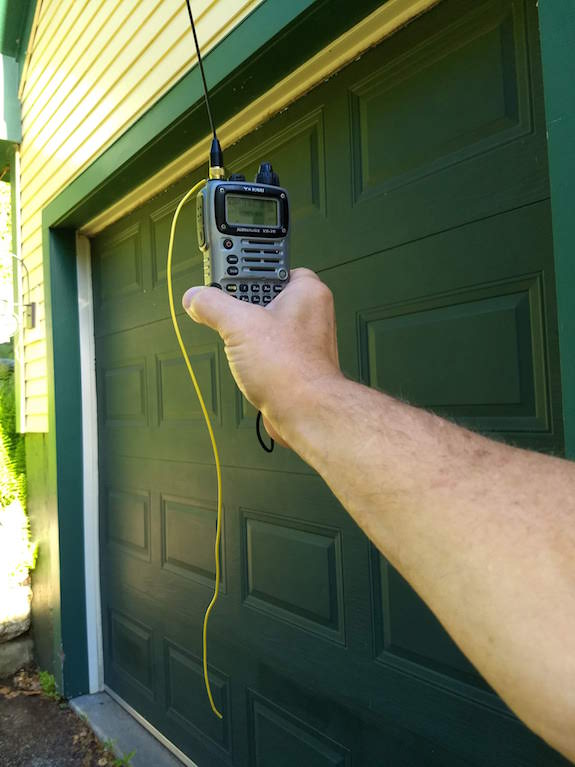
The yellow wire is a tiger tail antenna. It may not look pretty, but it dramatically increases the performance of the HT. Copyright 2018 Tim Carter W3ATB
“It’s probably best to just use a length of 19 and 1/4 inches to put you right about in the middle of the 2-meter frequencies.”
A Tiger Tail Antenna Boosts HT Output – HT on Steroids!
A tiger tail antenna is a short piece of flexible wire that connects to the ground side of your handheld transceiver (HT). They are easy to make and this simple additional wire will increase the outgoing strength of your signals.
What Is the Tiger Tail Antenna?
The tiger tail is the other side of a dipole antenna. The rubber duck antenna that comes with most HTs, or a good 1/4-wave high-gain whip antenna, is the positive side of the dipole. You create a high-performance antenna for your modest HT by attaching a matched length of wire to the negative, or ground, side of your antenna post.
How Long is the Tiger Tail Antenna?
You need to match the length of the tiger tail to the frequency you’ll be using on your HT. If you’re transmitting in the allowed portions of the 2-meter band in the USA, you’ll be between 144.00 and 148.00 MHz.
I used the ground plane calculator at Buxcomm.com to calculate it.
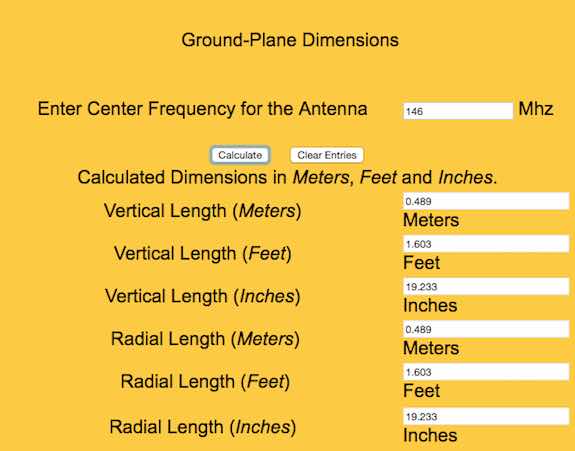
Look at the last value at the bottom: Radial Length (inches). That’s what you want. Copyright 2018 Buxcomm.com
Here are the lengths you’d need to cover the entire 2-meter band. It’s probably best to just use a length of 19 and 1/4 inches to put you right about in the middle of the 2-meter frequencies.
| 144.00 MHz | 19.50 inches |
| 145.00 MHz | 19.36 inches |
| 146.00 MHz | 19.23 inches |
| 147.00 MHz | 19.10 inches |
| 148.00 MHz | 18.97 inches |
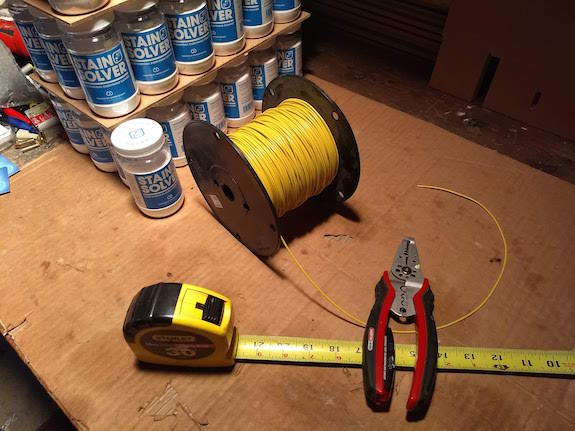
A tiger tail antenna requires simple wire, a wire cutter/stripper, a tape measure, and solder. I’m using 26-gauge stranded wire for mine. Copyright 2018 Tim Carter W3ATB
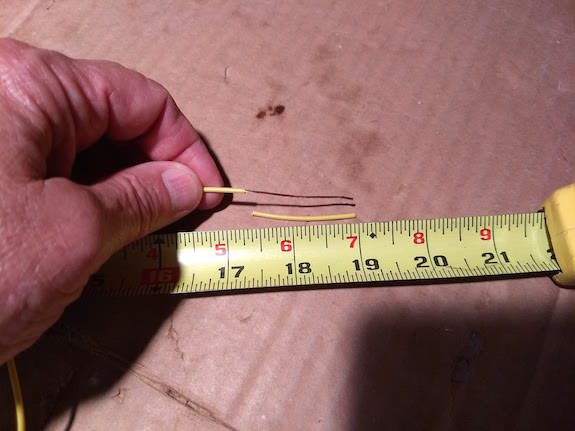
I stripped off 1.5 inches of insulation and twisted the strands of wire together. Copyright 2018 Tim Carter W3ATB
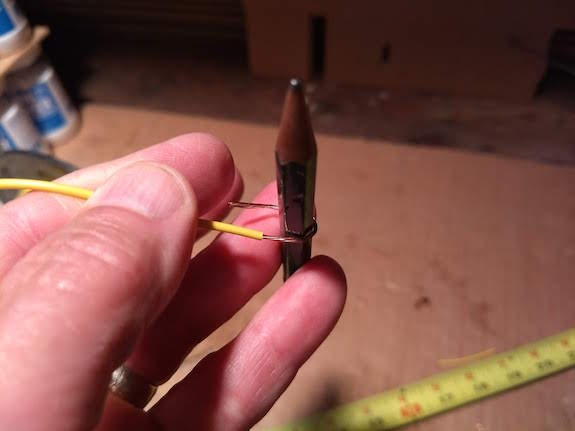
A standard pencil creates the perfect sized loop diameter for the tiger tail antenna. Copyright 2018 Tim Carter W3ATB
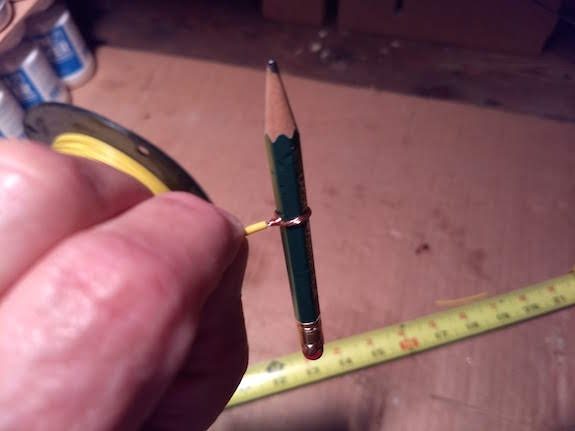
The loop is completed by wrapping the excess wire onto itself. All that’s left is to put a drop of molten solder on it so the loop stays intact. Copyright 2018 Tim Carter W3ATB
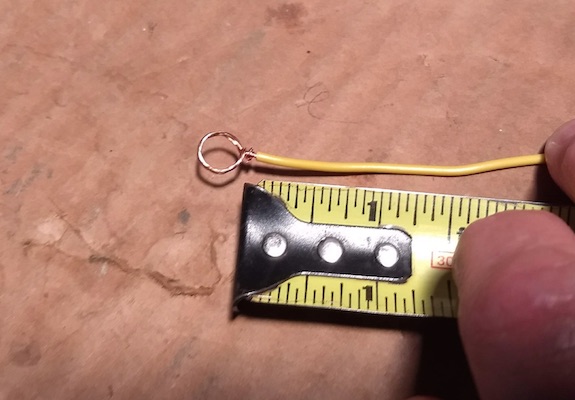
I still need to solder the loop, but you start your measurement for the tiger tail antenna at the base of the loop, NOT at the far end of the loop at the left. Copyright 2018 Tim Carter W3ATB

Great article and guide to making your own counterpoise tiger tail!
Thanks for putting this little gem to the web!
73, Dave N7IMD
What length for 477mhz cb. No being mathmaticly good ,..??
11.75 inches
468/ Freq MHz = length in feet, or 0.9811 feet
Multiply by 12 to convert to inches = 11.75 inches
Hi all,
This is a great idea and I am sure that it works extremely well. Here are a few additional comments from me:
1. The length given for the 477 MHz tiger tail above is incorrect, because the formula given calculates half a wavelength, and the tiger tail needs to be a quarter wavelength:
234/477 = 0.49 feet = 5.9 inches
2. Being one half of a dipole, it should actually be a few percent shorter to compensate for the thickness of the wire. 5% shorter would bring the length down to 5.6 inches, however it isn’t critical. Any length around 5-6 inches will work work well.
3. Yes, you could connect multiple tiger tails for a multi-band hand held. You would use one quarter wavelength tiger tail for each band you want to use (or 5% less as discussed above). Each tiger tail should hang separately, i.e. not closely coupled to the others. Obviously this gets a bit more messy / unsightly but it will work well.
4. A very tidy alternative to a tiger tail is to use an end-fed half-wave antenna, rather than a rubber ducky which is an electrical quarter wave. An end-fed half-wave has a much higher feed impedance than a quarter wave, and is therefore much less compromised by the imperfect counterpoise provided by a hand-held radio, that a tiger tail compensates for. It has a matching circuit at it’s base, which transforms the high feed impedance to 50 Ohms. A tiger tail would also work with an end-fed half-wave, but it would make much less difference.
73
Lew
VK2ZIP
Followup on notching the antenna surround on the Baofeng. The plastic is relatively soft. What worked was very careful cutting with one of those approximately “carpenter pencil” sized shop knives with an extendable blade, creating a flat notch about 3~4 mm wide. Concern was having enough turns of the antennas on the stub for adequate mechanical strengtht and keeping the mechanical load circumferentially even.
Did the quick’n easy 2m tiger tail from 28G solid strand make a difference? A quick test using a distant repeater indicated that repeater response was perhaps a few bars greater. The long 2m tails sure seemed to make a difference on 440. No repeater response.
73 KI7MBR
Hi Tim,
Comments and questions. Looks to be easy-peasy compared to using 14G wire and ring connector. Does wire gauge make a difference? I like the idea of light weight, but many of the other designs seem to use 14G.
Re the Baofeng “basin” around the antenna base, if notching is necessary, the best suggestion I have heard is using an exacto style knife warmed with butane lighter to melt through as needed.
I have seen a reference to hanging more than one tail from the radio, each trimmed for a different frequency. Sort of similar to the idea of a multi band antenna? The source seemed knowledgeable, but was curious if this concept had been tested.
To tidy up the longer 2m tail, can it be looped or folded back along itself without loss of fidelity?
Last, a fellow ham here, mentioned the possibility that tiger tails can make the signal directional.
Any thoughts on any of these most welcome. Thanks greatly in advance.
73 de KI7MBR
I’m not an antenna expert, nor do I play one on TV. As I say in the column above, it’s a simple dipole. Antenna modeling programs show that a dipole is directional to a degree.
All you have to do is just play with it. It takes seconds to install. Test it. Test all the questions you have above with several other operators who are part of the test. Try to do a test where you’re right at the edge of being heard by one operator. See if putting on the tiger tail HELPS you to be heard. Fold it, see what happens.
That’s the beauty of our hobby – you can test to death and rarely cause any damage. GL as we say in Morse.
Roger roger! 73 de KI7MBR 🙂
Hi Tim,
Thanks for putting this page together. Do you have any suggestions for getting a good connection to the ground plane on a Baofeng UV-5RA? This is what the antenna connection looks like:
https://imgur.com/350vIVF
Because of those nubs it looks like it would be hard to get it to seat properly.
Thanks!
The loop you see in my tiger tail will have no issues making contact with the threads on the SMA connection. That’s the negative side of the dipole you’re creating. Just tighten the antenna as tight as you can by hand and all should be well.
Got it, thanks. I’ll give it a go!
I have used an alligator clip on the wire and clipped to the loop that the wrist strap secures to.
W0 (zero) O (letter) PW (W0OPW) – My ex-husband in Pillager, MN (near Brainerd) sells antenna programs. He’s had a ham radio license for 60 years (age: 77). He would find this interesting, I’m sure. Thanks!